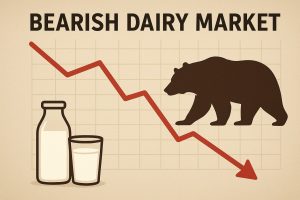
Exports have climbed to about 17% to 18% of U.S. milk production, and the U.S. global market share is expected to grow to 25% this year, compared with 20% in 2020, said Megan Sheets, senior director of strategic development and insights for the U.S. Dairy Export Council.
“We know that dairy exports are growing at twice the rate of domestic dairy consumption,” she said during the latest “DairyLivestream” webinar.
The outlook for U.S. dairy exports is optimistic, but the current environment is somewhat complicated. One of those short-term headwinds is supply chain challenges, she said.
“For the U.S. to be positioned as a global supplier of choice, we have to have a consistent and reliable supply,” she said.
The second challenge is inflation and its effects on global demand, and USDEC is starting to see consumer pushback. The third challenge is the tight milk supply in the U.S., although milk production grew slightly in June, she said.
Despite the current challenges, the long-term outlook is for continued growth in U.S. dairy exports, she said.
One reason is the lack of milk from key competitors, especially New Zealand and Europe, due to structural issues and environmental regulations.
“It’s really opening up the door for U.S. to gain additional market share and continue to build on the growth of market share momentum that we currently have,” she said.
Another tailwind is the booming cheese demand across the globe.
“What’s really positive for U.S. suppliers specifically is the cheeses that we’re seeing grow in consumer demand align really well with our U.S. portfolio of cheeses,” she said.
The U.S. is producing the right varieties — such as cream cheese, mozzarella and cheddar — for that demand.
Additionally, USDEC-commissioned research has identified the specific sensory attributes in cheese that consumers in different regions desire, she said
“So now we can be more competitive, we can be more forward-thinking and innovative … to ensure we’re continuing to meet this global demand for cheese and how we’re able to approach that in a really strategic way,” she said.
Another positive is the growing interest in health and wellness.
“From an international perspective, really what we’re seeing is a focus on nutrition, which really pairs well with what we’re seeing for a demand for proteins,” she said.
There’s an increase in consumption of proteins across the board, but consumers are specifically looking for high-quality dairy protein to fill their nutritional needs, she said.
Staff from each of USDEC’s 10 international offices recently reported health and wellness and sustainability are important to consumers in those markets, she said.
“That strong interest in health and wellness we know will fuel demand for many different dairy categories,” she said.
While there are some short-term headwinds, the longer term outlook for export growth is promising. It comes down to having product to export and remaining competitive, she said.

























